Peronosporosis (downy mildew) on cucumbers: description and causes of the disease, methods of control and treatment
Do you have yellowed cucumber leaves, or rather, light yellow spots in the form of a mosaic appeared on them? Most likely it is downy mildew (downy mildew), although, of course, there are other causes of yellowing of cucumber leaves.
Well, then we will talk about what peronospora in cucumbers is, how to recognize it, how to treat it to protect (prevent) and combat the immediate symptoms of the disease.
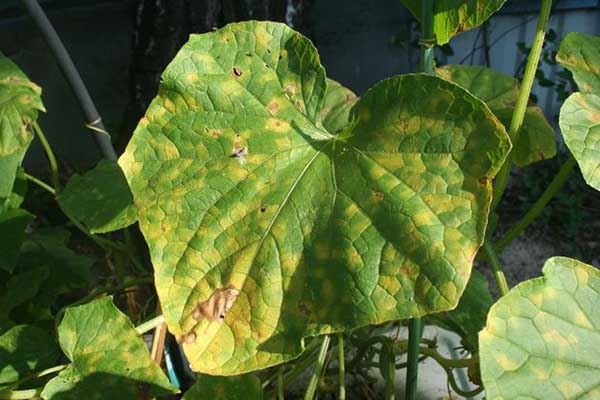
Content
What is peronosporosis (downy mildew) of cucumber: symptoms and causes
Cucumber downy mildew or downy mildew is a widespread fungal disease that affects plants both outdoors and in the greenhouse.
The causative agent of the disease is the lower fungus oomycete Pseudoperonospora cubensis, which can survive in seeds, as well as hibernate in plant debris and in the soil.
Under favorable weather conditions, spores of the fungus germinate and begin to spread over the site by the wind along with water droplets.
Interesting! Peronosporosis affecting cucumbers and other pumpkin seeds is very similar to phytophthora (you can even say that this is her closest relative), which overcomes nightshade crops (tomatoes and potatoes). In general, the control and prevention measures are very similar (including the same fungicides for treatment).
By the way! Peronosporosis also affects onions, garlic and grapes (mildew).
Favorable conditions conducive to the appearance and development of downy mildew on cucumber leaves:
- the presence of dew (drip moisture) on the leaves for 6 or more hours;
Spores will not germinate on dry leaves, but on wet leaves they will.
- moderate temperature - +18 .. + 23 and high relative humidity - 80-100%.
Thus, infestation usually occurs after cold rain (when grown outdoors). the soil evaporates moisture for a long time (humidity rises) or strong temperature drops at night (cold dew) in the greenhouse, which contributes to the development of the disease.
Accordingly, the maximum harm is observed in the second half of the growing season (from the second half of July-early August and September-October, depending on the climatic characteristics of the region and the weather conditions of the season).
Well, if your cucumber plant has contracted a fungal disease such as peronosporosis (downy mildew), then in general it will manifest and proceed as follows (= symptoms):
- On the affected leaves, mottling first appears, and then light yellow spots (in the form of a mosaic pattern). These spots have angular shape and limited by small leaf veins.
- Gradually, these spots merge and turn into lesions, the color of which ranges from yellowish brown to brown.
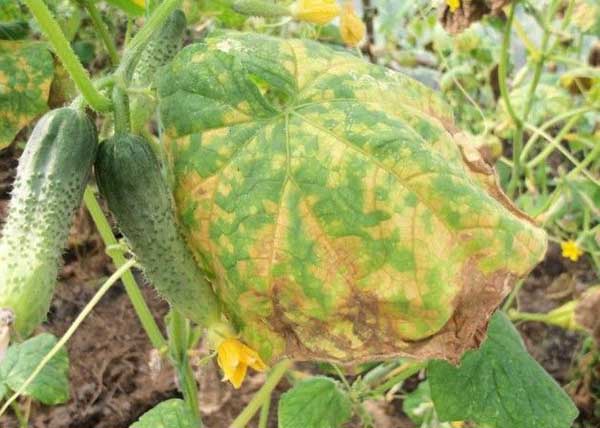
- After some time, a fluffy bloom of fungal sporulation forms on the lower (inner) surface of the leaf, the color of which varies from white to gray.
During periods of high humidity, this plaque can acquire a gray or even purple color.
- Affected leaves begin to die off, but remain erect, while the edges of the leaf blade curl inward.
Obviously, the oldest leaves have the greatest damage, and the new growing leaves acquire symptoms of the disease gradually.
- The leaves turn yellow, dry out and fall off, ceasing to perform their main function (photosynthesis), due to which plants lag behind in growth and underdevelopment of fruits, in other words, the fruiting period is shortened and the yield decreases (due to the weakening of the plant).
However! You must understand that downy mildew is not a death sentence for your cucumbers. The disease is being treated, which means that the plants can still bear fruit normally, of course, if you take the necessary measures.
Agrotechnical measures for the control and prevention of downy mildew on cucumbers
If this is not the first time you observe peronosporosis on cucumbers in your area, then it will not hurt you to familiarize yourself with the basic agrotechnical protection and control measures that will allow you to avoid or at least reduce its harmfulness:
- destruction (burning) or removal of plant residues from the site after harvesting;
- digging (or loosening) and subsequent disinfection of the soil (spillage with a fungicide) or complete replacement of the top soil layer in the greenhouse;
And in the open field you need annually change landing site (observe the rules of crop rotation and crop rotation).
- seed treatment before planting;
- dressing (disinfection) of soil before or after planting seeds;
- planting varieties and hybrids resistant to downy mildew (downy mildew);
Among the most resistant bee-pollinated varieties of cucumbers, the following should be noted: Verasen, Phoenix + and Phoenix 640.
- creating and maintaining an optimal microclimate in greenhouse conditions (maintaining normal air and soil humidity, correct watering and periodic ventilation);
- excessive solar radiation has a positive effect on the onset and development of the disease, therefore, it is better to choose a place for a garden in open ground in a light partial shade or grow under a spunbond so that it shades the plants (relevant only for southern sunny regions).
- regular preventive (protective) treatments with biological or chemical agents (fungicides) during the growing season;
- timely removal of affected leaves and their subsequent burning or removal from the site.
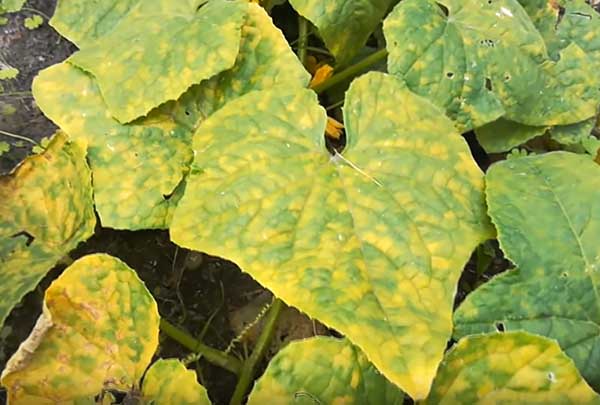
How to relieve stress and support a weakened plant
In case the cucumbers still get sick with peronosporosisthen it is highly desirable start additionally feeding them with variousimmunostimulants (e.g. Epin) to support plant immunity, help relieve stress and enable better absorption of food (for quick recovery).
- For example, Fosetyl (Fosethyl aluminum) Is one of the best immunostimulating agents for the prevention and treatment of peronosporosis.
Fosetyl aluminum is contained in the preparation Previkur Energy or Altt (relevant for residents of Ukraine).
- Interestingly, potassium monophosphate is also a good tool for the prevention and control of downy mildew.
The fact is that phosphorus and potassium increase the resistance of plants against pathogens (= improves immunity), especially in such an easily digestible form.
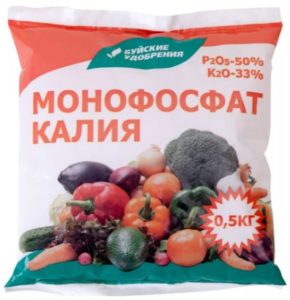
How to deal with downy mildew on cucumbers: how to treat downy mildew
So what drugs are suitable for treating cucumbers for peronosporosis?
Let's list it now. But first, you should familiarize yourself with the basic recommendations for their proper use, so that your sprays are truly effective and safe.
Spraying rules: how to most effectively and safely carry out treatments
- It is necessary to start preventive treatments immediately after planting the seedlings or after the formation of the first ovaries (with direct sowing of seeds immediately into the ground).
- Treatments are best done in the morning.
The fact is that evening processing can lead to the fact that the leaves do not have time to dry out and remain wet overnight.
- Spraying, especially when using biological fungicides, should be carried out regularly, approximately every 7-14 days.
- Treatments are recommended to be carried out alternately, with drugs with different active substances (i.e. alternate means), so as not to cause addiction and adaptation of the fungus (resistance).
So always pay attention on the active ingredient, not just the name.
- Chemical fungicides always have a waiting period, so you need to process it after you pick up the greens, because harvesting will be possible after some time (usually from several days to several weeks).
- Biological fungicides either do not have a waiting period at all, or it is very short, but in any case, it is imperative to wash the greens with water before use.
Important! Always read the instructions carefully, paying attention to the waiting period, the beginning (when to carry out the first spraying), the number and frequency of the recommended treatments.
Chemical fungicides
The following chemicals will help you effectively protect cucumber plants from peronosporosis (the active ingredients, the nature and method of action of the drug are indicated in brackets):
- Previkur Energy (Propamocarb and Fosethyl aluminum, a systemic fungicide of protective and immunizing (growth-stimulating) actions, a class of organophosphorus compounds (FOS), from peronosporosis, root and root rot);
It is applied specifically for:
- glaze soil (substrate) before or immediately after planting seeds;
- watering seedlings at the root 14 days after sowing seeds and during the growing season with an interval of 14 days.
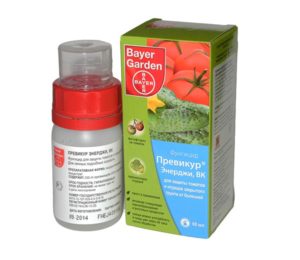
- Altt (Fosetyl aluminum, systemic fungicide of protective and immunizing (growth-stimulating) action, a class of organophosphorus compounds (FOS), from peronosporosis, root and root rot).
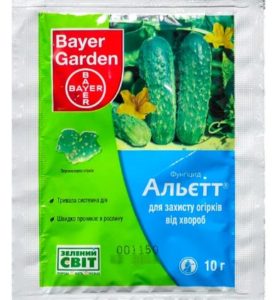
Relevant only for Ukraine, Previkur Energy is used in Russia or simply Fosetyl aluminum.
And the following fungicides are used specifically for spraying plants during the growing season:
- Abiga Peak (Copper oxychloride, contact fungicide of protective action);
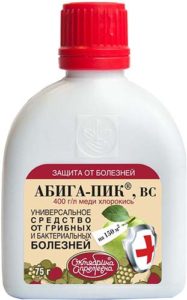
- Hom (Copper oxychloride, contact fungicide of protective action);
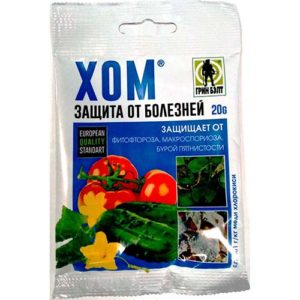
- Oxyhom (Copper oxychloride and Oxadixil, systemic contact fungicide of protective action);
The first treatment is carried out when the first signs of the disease appear, the subsequent ones - with an interval of 7-10 days, depending on the development of the disease.
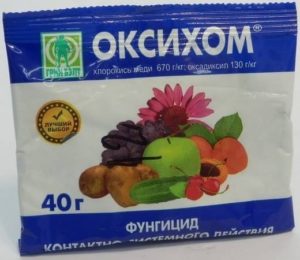
Other copper preparations, for example, the same copper sulfate (copper sulfate) and bordeaux liquid.
However, as practice shows, the effectiveness of fungicides based on copper sulfate is lower than copper oxychloride.
- Consento (Propamocarb and Hydrochloride, systemic fungicide of protective action);
The first spraying is preventive, all subsequent spraying - with an interval of 7-10 days.
- Metaxil (Metalaxil and Mancozeb, systemic contact fungicide of protective action);
The first is prophylactic, all subsequent ones - with an interval of 10-14 days.
- Acrobat MC (Dimethomorph and Mancozeb, fromsystemic contact fungicide of protective and curative action);
- Ridomil Gold (Mancozeb and Mefenoxam, contact-systemic fungicide of protective and curative action).
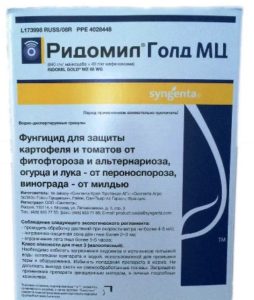
- Quadris (Azoxystrobin, a systemic contact fungicide of a protective action, against peronosporosis and powdery mildew).
Spraying during the growing season before and after flowering with an interval of 7-14 days.
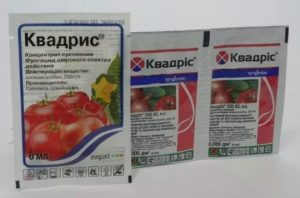
- Strobe (Kresoxim-methyl, systemic fungicide of protective and curative action).
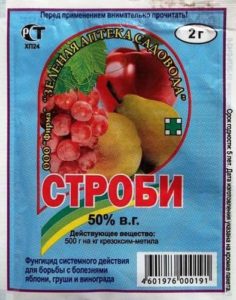
Biological fungicides
Of course, it is much more environmentally friendly to use biological preparations to protect cucumbers from peronosporosis:
- Baxis (Bacillus subtilis strain 63-Z, fungicide of prophylactic and curative action, against peronosporosis, root and root rot);
- Alirin-B (Bacillus subtilis strain B-10 VIZR, a systemic contact fungicide of a protective, immunizing and curative effect, against peronosporosis, powdery mildew, root and root rot, tracheomycotic wilting);
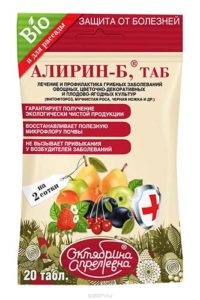
- Gamair (Bacillus subtilis strain M-22 VIZR, a systemic contact fungicide of a protective, immunizing and curative effect, against peronosporosis, powdery mildew, root and root rot, tracheomycotic wilting);
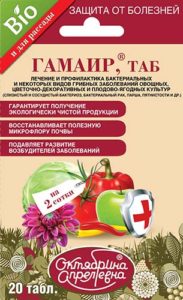
All of the above biofungicides can be used for:
- Pre-sowing seed soaking;
- Application to the soil (watering the soil) before and / or after sowing;
- Spraying during the growing season.
- Trichoderma Veride 471 (Trichoderma veride, strain 471, a protective fungicide, against peronosporosis, against root and basal rot, tracheomycotic wilting);
For spraying during the beginning of flowering-fruiting.
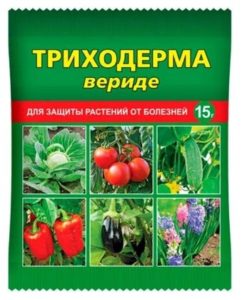
- Fitosporin (Bacillus subtilis strain 26 D, a systemic fungicide of protective and curative action, against peronosporosis, powdery mildew, root and root rot, fusarium wilting).
The first spraying is prophylactic, the subsequent spraying at intervals of 7-10 days (in the greenhouse) and 10-15 (in the open field).
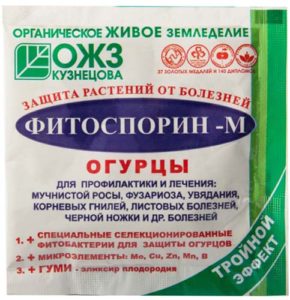
Well, now you know everything about effective methods of preventing and combating peronosporosis on cucumbers. Let your cucumbers not get sick, but you continue to collect greens even in autumn!
And what are you doing to combat peronosporosis and prolong the fruiting of cucumbers?

